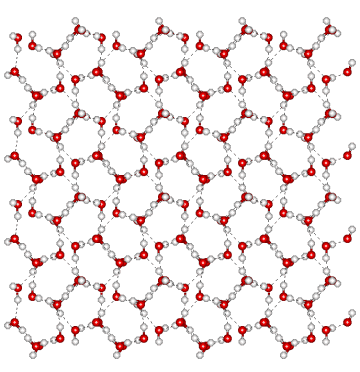Ice-nine crystal

Ice-nine (ice IX) [3818] is the low-temperature equilibrium, slightly denser, structure of ice-three (Space group P41212, cell dimensions 6.692 Å (a) and 6.715 Å (c) at 165 K and 280 MPa [385]). Ice III has a hydrogen-disordered structure and exists between -24 °C (249 K) and -44 °C (229 K) and between 240 and 340 MPa. In 1967, it was found that ice III gradually transforms, between -65 °C (208 K) and -108 °C (165 K) and within this pressure range, into the ordered hydrogen-bonded structure, ice IX [3818]. At in-between temperatures, ice II is irreversibly formed. The 'a' lattice constant expands upon hydrogen ordering, while the 'c' lattice constant contracts. This yields negative thermal expansion due to the buildup of torsional strain within the a-b plane with the helical "springs" within the structure expanding upon heating [4338].
Ice-nine is metastable in the ice-two phase space and readily converts to ice-two on warming, rather than back to ice-three. The change from proton disordered is a partial process starting within ice-three that is only completed at lower temperatures but with a first-order transition near 126 K [1087]. The hydrogen-bonding is mostly proton-ordered as ice-three undergoes a proton disorder-order transition to ice-nine when rapidly cooled in liquid nitrogen (77 K, so avoiding ice-two formation, see Phase Diagram); ice-three and ice-nine having identical structures and densities apart from the proton ordering [389]. The vibrational spectrum of ice IX has been examined using a density functional theory-based method [3820]. The phase transition boundary between the ice phases IX and XIII have been predicted, based on the second-order Møller–Plesset perturbation (MP2) theory, as occurring at ~0.30 GPa and 154 K [3912]. The near-infrared spectra of ice-nine has been compared with that of hexagonal ice [4189].
Interactive Jmol structures are given.
The ice-nine, described by Kurt Vonnegut in 'Cat's Cradle' four years earlier than the discovery of real ice-nine[83], with a freezing point well above ambient temperature under normal atmospheric pressure is, fortunately, an utterly fictitious material possibly based on polywater, reportedly invented by the Nobel prize winner Irving Langmuir to entertain H. G. Wells. In that novel, it was proposed that this ice was stable and, once formed, could nucleate crystalline ice-nine any liquid water it came into contact with, resulting in a global catastrophe.
Home | Site Index | Phase Diagram | Ices, introduction | Ice-Ih | Ice-Ic | Ice-Isd | II | III | IV | V | VI | VII | VIII | X | XI | XII | XIII | XIV | XV | XVI| XVII | XVIII | Amorphous ice | LSBU | Top
This page was established in 2004 and last updated by Martin Chaplin on 20 September, 2021